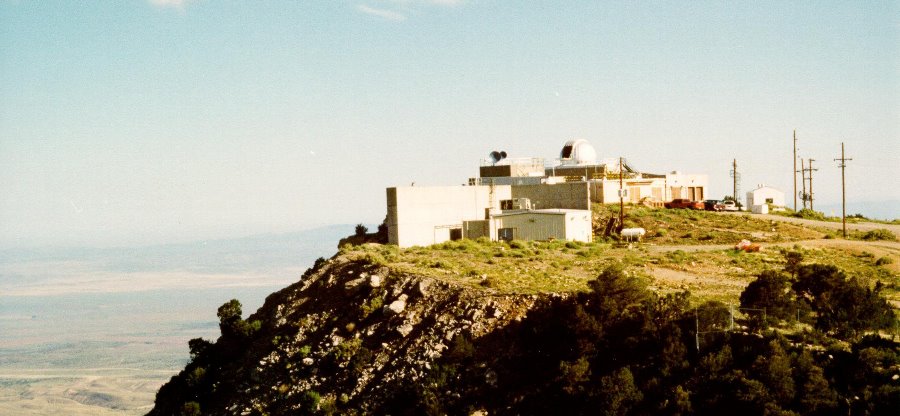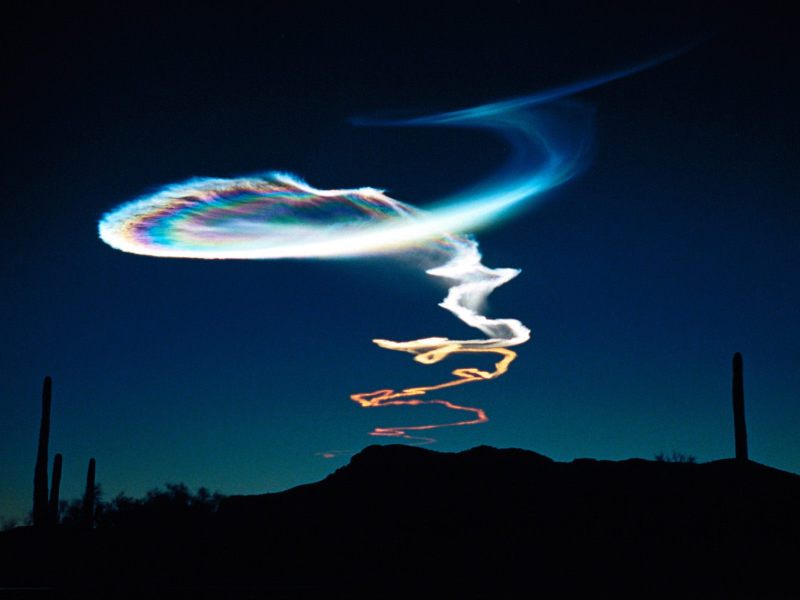|
North Oscura Peak White Sands Missile Range, New Mexico |
|
North Oscura Peak is an Air Force Research Laboratory site in the northern portion of the U.S. Army’s White Sands Missile Range, New Mexico. The facility is designed to assemble and evaluate advanced sensor, tracking and atmospheric compensation systems. The goal is to improve the U.S. Air Force’s ability to track missiles and then efficiently transmit laser energy through the atmosphere to destroy those missiles. The site is managed by the Laboratory’s Directed Energy Directorate, headquartered at Kirtland Air Force Base, about 140 miles to the north. Atop the 8,000 foot high North Oscura Peak, a 30 inch telescope is used to send and receive laser light to and from Salinas Peak, another site approximately 35 miles away. Sophisticated instrumentation is used to measure the extent that Earth’s atmosphere distorts the laser light. Then, deformable optics are used: mirrors that can change their shape to compensate for the distortions. The research gained from these tests will benefit any follow on efforts to the Airborne Laser – a large cargo aircraft, equipped with a highenergy laser that can destroy theater ballistic missiles hundreds of miles away. In contrast to the Airborne Laser, which is designed to operate at altitudes around 40,000 feet, these tests are taking place on peaks that are between 8,000 and 9,000 feet high. The denser air at these lower test elevations makes it possible to take the collected data and scale it to the higher altitudes and longer ranges envisioned for the Airborne Laser. Research at this site may be applied on the first three Airborne Laser production aircraft or as advanced weaponry on tactical aircraft. A 30 inch telescope was initially used, one of the
largest refractor telescopes in the world. However, in late January of
1999, it was replaced with a $2.5 million, 1 meter (40inch) telescope build
for the Research Laboratory by Contraves Brasher Systems in Pittsburgh,
Pennsylvania. Unlike the initial telescope, which was stationary, the new
telescope was
By June of 1999, the Air Force will be able to fire its nondestructive lasers at a variety of missiles being launched at White Sands Missile Range. Although three to four missile launches may take place each year, Laboratory scientists will be getting better data from a different “target” – a single engine, propeller driven Cessna Caravan airplane. This test aircraft will carry a scoring board comprised of a range of detectors that will be able to gather greater amounts and more complete information than will be available from the missiles. Overall, 40 people are working on the project, most
of whom reside in offices at the Directed Energy Directorate at Kirtland
Air Force Base, about 140 miles away. Six to eight people work at the site
with four of them there full time.
During a test, North Oscura and Salinas Peaks are in constant communications, and a laser cannot propagate unless several failsafe measures are in force at both locations. These are among the safety precautions in place to ensure eyesafe operations. North Oscura Peak was a former Army missile tracking site. Designed to withstand rocket strikes, the walls at the site are 4 feet thick, with 1,200 tons of concrete embedded six feet in bedrock. The Directed Energy Directorate refurbished the site in June of 1997, spending approximately $700,000 to repair the buildings, bring in the telescope, build a clean room, and install lasers, advanced optics, computers and test instrumentation. The money also included improvements to the receiver station at Salinas Peak, where three portable shelters, an electronics room and an optics room were installed. AFRL Current SOURCE: AFRL Fact Sheet PDF |
|
| Oscura Range
http://www.globalsecurity.org/military/facility/oscura.htm |
|
|
..
White Sands Missile Range (WSMR) is the largest military installation in the United States. At 3,200 square miles it is large enough to contain the states of Delaware and Rhode Island. The missile range is about 100 miles south to north and at its widest point it is 40 miles from east to west. The main post, where most of the range's personnel work, is located in the southwest corner just south of U.S. Highway 70. The facility used to manage assets at the north end of the sprawling range is Stallion Range Center. Several hundred people, ranging from security guards to engineers, work out of Stallion which is near Socorro. White Sands is big enough to contain two mountain ranges, the San Andres and Oscuras. The Oscura Mtns. are at the north end of the range. The highest point is Oscura Peak at 8,639 feet. The missile range maintains a communications site on the highest mountain in the San Andres Mtns. which is Salinas Peak at 8,965 feet. Between the San Andres Mtns. on the west and the Sacramento Mtns. on the east is the Tularosa Basin. The missile range occupies the western portion of this drainless basin which was formed 10 million years ago. Other natural resources on the range include a lava flow along the northeast boundary and hundreds of acres of white gypsum sand dunes which are not part of White Sands National Monument. Contained within the missile range's boundaries are White Sands National Monument, under the control of the National Park Service, and the San Andres Wildlife Refuge, under the auspices of the U.S. Fish and Wildlife Service. Also, the Dept. of Agriculture's Jornada Experimental Range overlaps the west boundary of White Sands. There are agreements in place between the missile range and the monument, refuge and experimental range which control military access to these lands and allow military use of the airspace overhead. The public has access to the monument but the other agency lands on WSMR are off limits. White Sands also has two national historic landmarks. The best known is Trinity Site where the world's first atomic bomb was tested on July 16, 1945. The site is located at the base of the Oscura Mtns. near Stallion Range Center. The other landmark is Launch Complex 33 where dozens of German V-2 rockets were launched and other early space-related technology was developed. The White Sands logo, "Birthplace of America's Missile and Space Activity," is derived from this work. More than 1,100 miles of roads crisscross this large expanse of desert and mountain terrain, which amounts to nearly 10 percent of all the roads within the Department of Army. This column was prepared by WSMR's Public Affairs Office. For further information concerning its content, please call the office at (505) 678-1134. SOURCE: White Sands Missle Base |
|
|
|
| FAIR USE NOTICE: This page contains copyrighted material the use of which has not been specifically authorized by the copyright owner. Pegasus Research Consortium distributes this material without profit to those who have expressed a prior interest in receiving the included information for research and educational purposes. We believe this constitutes a fair use of any such copyrighted material as provided for in 17 U.S.C § 107. If you wish to use copyrighted material from this site for purposes of your own that go beyond fair use, you must obtain permission from the copyright owner. | |
|
|



